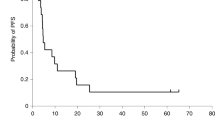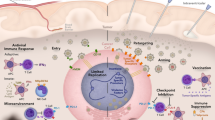Abstract
Infection of rat RT2 glioma cells in vitro with an adenovirus (ADV-TK) expressing herpes simplex virus (HSV) thymidine kinase (TK) and subsequent exposure to 5-bromo-2′-deoxycytidine (BrdC), which is specifically incorporated into ADV-TK-infected cell DNA as 5-bromo-2′-deoxyuridine (BrdU), results in significant radiosensitization (sensitizer enhancement ratio: 1.4–2.3) compared with Adβgal-infected cells. Cell killing correlated well with increased BrdU DNA incorporation and with apoptosis. Whereas radiation (4 Gy) alone was relatively ineffective in inducing apoptosis, treatment with HSV-TK/BrdC resulted in BrdC dose- (10–100 μM) and time-dependent (24–48 hours) increases, and the combination of the two treatments produced a synergistic response (1.5- to 2-fold). To investigate the effects of the ADV-TK/BrdC treatment in vivo, RT2 cells were grown as soft tissue tumors in Fischer 344 rats and conditions for virus infusion were optimized by altering the volume and rate of infusion using a rate-controlled positive pressure device. We found that relatively large volumes (100–150 μL) of virus delivered at rates of ≤1 μL/minute were optimal and gave uniform and reproducible results. Using these optimal infusion conditions, we were able to achieve 40% adenovirus infection in the tumor. Infection of RT2 tumors with ADV-TK and continuous administration of BrdC from an osmotic pump resulted in significant (.001 < P < .009) tumor regression 6 days after radiation (30 Gy delivered as 2 × 5 Gy over 3 days) compared with controls. In situ staining of sectioned tumors with anti-BrdU antibody or by high-performance liquid chromatography analysis of extracted and hydrolyzed tumor DNA confirmed that we obtained efficient and specific incorporation of BrdU into tumor cells. These results suggest that adenovirus-mediated delivery of HSV-TK in combination with BrdC and radiation can potentially be an efficient combination modality for the treatment of gliomas.
This is a preview of subscription content, access via your institution
Access options
Subscribe to this journal
Receive 12 print issues and online access
$259.00 per year
only $21.58 per issue
Buy this article
- Purchase on Springer Link
- Instant access to full article PDF
Prices may be subject to local taxes which are calculated during checkout
Similar content being viewed by others
Author information
Authors and Affiliations
Rights and permissions
About this article
Cite this article
Brust, D., Feden, J., Farnsworth, J. et al. Radiosensitization of rat glioma with bromodeoxycytidine and adenovirus expressing herpes simplex virus-thymidine kinase delivered by slow, rate-controlled positive pressure infusion. Cancer Gene Ther 7, 778–788 (2000). https://doi.org/10.1038/sj.cgt.7700168
Received:
Accepted:
Published:
Issue Date:
DOI: https://doi.org/10.1038/sj.cgt.7700168
Keywords
This article is cited by
-
External irradiation models for intracranial 9L glioma studies
Journal of Experimental & Clinical Cancer Research (2010)



